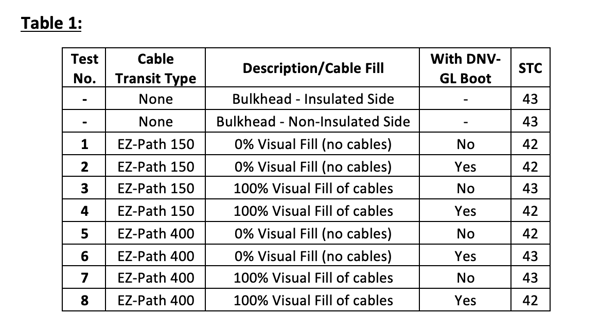EZ Path® MDM 150 & 400 Fire-Rated Cable Transit Sound Transmission Loss Testing
Bulkheads and Decks, built to contain both fire and sound, are commonplace in modern shipbuilding construction. Beyond the protection of occupants and property, personal privacy is of ever-increasing importance. For this reason, divisions are constructed with elements to reduce sound transmission. These elements could range from incorporating various types of materials or insulations, to increased thicknesses of these products. To quantify the performance of these barriers, sound transmission loss testing is typically conducted. These tests are often conducted to ASTM E90, Standard Test Method for Laboratory Measurement of Airborne Sound Transmission Loss of Building Partitions and Elements. The ability to resist the passage of sound can be demonstrated by an STC (Sound Transmission Classification) number. A higher STC number represents a greater resistance to sound. And, when penetrating divisions, with items such as pipes or cables, the goal is to try and maintain the performance of the barrier as close as possible to its original performance, whether it is for fire protection or for sound integrity.
EZ-Path MDM 150 & 400 Fire-Rated Cable Transits were recently tested in accordance with ASTM E90, to determine how well they would maintain the performance of a typical A-60 steel fire rated steel bulkhead (See Fig. 1 – 4). Four tests were conducted with each of the two types of cable transits and the results are shown in the table below (See Table 1). The cable transits were installed in an A-60 rated steel bulkhead sample that was insulated with 60mm thick A-60 mineral wool insulation, on one side. The construction of the bulkhead and installation of the cable transits were in accordance with the installation instructions and referenced Type Approvals*.


Multiple configurations were tested to verify that the sound performance would be consistent. As can be seen in the data collected from the testing, little to no sound loss was measured whether the cable transits were empty, completely filled with cables (100% visual fill) or if a fiberglass fabric boot was secured to one side of the cable transits.
Construction of divisions vary as do the sound requirements. But whether these sound requirements are high or low, the sound loss would be expected to be minimal when using EZ-Path Cable Transits. EZ-Path Cable Transits have been engineered to save time, resources, and downstream costs. They are simple, self-sealing devices that have nothing to activate and have no moving parts. You simply have to push or pull the cables through them. They are always compliant, 100% of the time, and are completely maintenance free.
Sound performance can now be added to the long list of advantages and benefits of using EZ-Path Cable Transits!
Issued by,
Julio Lopes (ext. 1034)
Sr. Engineering Manager
References: *Bulkhead insulated per DNV-GL Certificate No. MEDB00002HN. Drawing 430-1 & 430-3 Section B. EZ-Path 150 & 400 Cable Transits installed and insulated per LR Certificate No. SASF160267-M1-05. Fabric Boot (Cat no. MDMBOOT) installed per DNV-GL Certificate No. TAF0000177 & TAF0000178.





